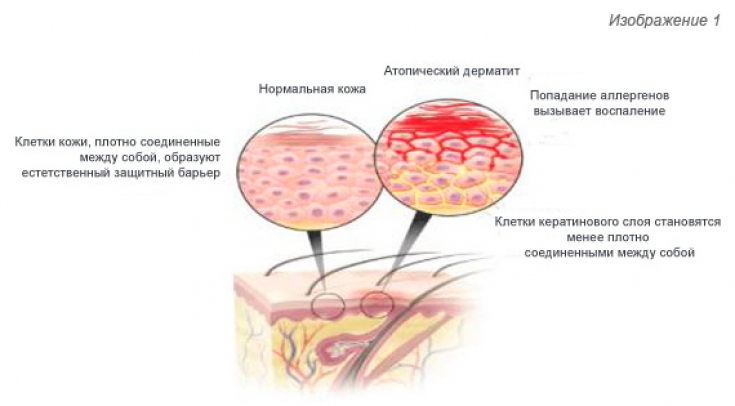Atopic dermatitis, a common inflammatory skin disease also known as allergic eczema, affects nearly 20% of children, 30% of whom also have food allergies.
It is believed that the destroyed epithelial barrier is central a factor in the development of allergic pathologies such as atopic dermatitis (allergic eczema), which is usually associated with food allergies.
In this study, scientists analyzed the outer stratum corneum of the skin. It has been found that people suffering from atopic dermatitis and food allergies at the same time have structural and molecular differences in the upper layers of the skin near eczema lesions, while people with atopic dermatitis alone do not show such a relationship.
In the article estet-portal.com you can read the research results in detail.
Study of skin composition in patients with allergic eczema and food allergies
Patients with atopic dermatitis develop patches of dry, itchy, scaly skin caused by allergic inflammation. Symptoms of atopic dermatitis range from mild itching to severe discomfort that can disrupt sleep and can lead to recurrences of infection on the injured, broken skin.
Follow us on Instagram
The study, conducted in Denver (USA), involved the study of the upper layer of the skin, known as the stratum corneum, in areas of eczema and in adjacent skin. The study involved 62 children aged 4 to 17 years who had atopic dermatitis and peanut allergy, or atopic dermatitis and no signs of food allergy, or no disease (control group).

The researchers collected skin samples by applying and removing small sterile strips of tape on the same area of the skin. At each removal, a microscopic sublayer of the first layer of skin tissue was collected and stored for analysis. This method allowed researchers to determine the composition of the skin: cells, proteins and fats, as well as its microbial communities, gene expression in skin cells and water loss through the skin barrier.
Distinctive features of the skin in patients with allergic eczema and food allergies
Researchers found that skin rashes in children with atopic dermatitis and food allergies were indistinguishable from skin rashes in children with atopic dermatitis alone.

However, they found significant differences in the structure and molecular composition of the top layer of intact, healthy skin in children with atopic dermatitis and food allergies compared to children with atopic dermatitis alone.
It has been found that in patients with atopic dermatitis and food allergies:
1. transepidermal water loss increases;
2. there is a decrease in filaggrin and the proportion of sphingosine-ceramide ω-hydroxy fatty acids in unaffected skin;
3. the content of Staphylococcus aureus increases;
4. the expression of keratins 5, 14 and 16 increases, indicating hyperproliferation of keratinocytes;
5. Increased expression of genes for dendritic cells and type 2 immune pathways.
Treatment of atopic dermatitis and alopecia: dual action of dupilumab
"Atopic March": causes of pathological chain reaction
Skin without lesions in children with atopic dermatitis and food allergies was more prone to water loss, had an abundance of Staphylococcus aureus bacteria, and had increased gene expression typical of an immature skin barrier. These abnormalities have also been found in skin with active AD lesions, suggesting that the skin abnormalities extend beyond the visible lesions in children with AD and food allergies, but not in children with AD alone.
This information may help identify patients most at risk of developing food allergies before they develop an overt skin rash.
Allergy experts consider atopic dermatitis to be an early step in the so-called "atopic march", a common clinical progression seen in some patients in whom atopic dermatitis progresses to food allergies and sometimes to allergic rhinitis and allergic asthma.

Many immunologists suggest that food allergens can more easily reach immune cells through a dysfunctional skin barrier affected by atopic dermatitis, thereby triggering the biological processes that lead to food allergies.
Thank you for staying with estet-portal.com. Read other interesting articles in the "Cosmetology" section. You may be interested in New options for the treatment of atopic dermatitis in children and adults







Add a comment